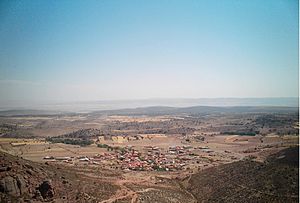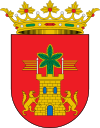Peracense facts for kids
Quick facts for kids
Peracense
|
|||
|---|---|---|---|
 |
|||
|
|||
| Country | Spain | ||
| Autonomous community | Aragon | ||
| Province | Teruel | ||
| Comarca | Jiloca | ||
| Area | |||
| • Total | 28.66 km2 (11.07 sq mi) | ||
| Elevation | 1,217 m (3,993 ft) | ||
| Population
(2018)
|
|||
| • Total | 76 | ||
| • Density | 2.652/km2 (6.87/sq mi) | ||
| Time zone | UTC+1 (CET) | ||
| • Summer (DST) | UTC+2 (CEST) | ||
Peracense is a small town in the province of Teruel, located in the Aragon region of north-east Spain. It is about 51 kilometers (32 miles) away from Teruel, which is the capital city of the province.
The town is famous for its amazing medieval castle, which is its main attraction. But Peracense also has other cool cultural and natural spots to explore.
Contents
Where is Peracense Located?
Peracense is in the western part of the Teruel province. It is the southernmost town in the Jiloca Region. The town covers an area of about 28.7 square kilometers (11.1 square miles).
It shares borders with Villar del Salz to the north and Villafranca del Campo to the east. To the south, it borders Almohaja, and to the west, Ródenas. You can reach Peracense mainly by local roads TE-58 and TE-V-9024. These roads connect to the A-23 highway, which is a major route in the region.
A Look at Peracense's Past
The earliest people known to live in Peracense were from the Iberian Period. This was a long time ago! We know this from old sites like El Palomar, near the town center. Even at the castle, pieces of ancient Iberian pottery have been found. This suggests people lived here even before the castle was built.
The first time Peracense was written about was in 1220. This was in a document called the Cartulario de Aliaga. This document talked about the Knights Templar, a famous group of medieval knights. Peracense was mentioned as a boundary in their records.
For many years, Peracense belonged to the family of Juan Jiménez de Urrea. In 1336, they sold the village to the Community of Daroca's Villages. From then on, Peracense was part of the Rio Jiloca's Town Association. Later, it became an independent village in 1785.
Who Lives in Peracense?
In 2009, Peracense had 93 people living there. This means there were only about three people per square kilometer. The town has a very old population. For example, half of the people are over 65 years old. The average age is around 60 years old.
This happened because many people moved away from rural areas in Spain during the second half of the 20th century. In 1930, Peracense had 455 people, which was its highest number ever. Since then, it has lost almost 80% of its working population.
Today, the local government is working hard to bring more people and jobs back to the town. They are part of programs to help the population grow.
What Do People Do for Work?
For a long time, the main jobs in Peracense were farming and raising animals. About 1,000 hectares (2,470 acres) of land are used for crops. This is almost 36% of the town's total area. There are 19 family farms in the village. They mostly grow winter cereals like wheat and barley.
Many farms also raise animals. The town has about 1,500 animals, with 1,300 of them being sheep. Besides farming, Peracense has other businesses too. There are businesses in energy, construction, and services.
The town is trying to attract more tourists. They want to show off the amazing medieval castle and the beautiful natural scenery.
Peracense's Culture and Fun
Town Celebrations
Peracense celebrates its main festivals, called Fiestas de San Gines, on August 25. This is in honor of the town's patron saint. On August 26, they celebrate the Virgin of the Villeta.
Medieval Reenactments
Every year in early August, since 2006, the Peracense castle hosts a special event. Groups of people gather to recreate the Medieval era. They want to show what life was like in the castle around 1210. At that time, the Peracense fortress was a border with the Muslim Kingdom of Valencia.
For four days, the castle comes alive! Different groups set up areas like a forge (where metal is shaped), a kitchen, a guard hall, and a chapel. They pay great attention to historical details. In 2010, 15 groups from Spain and Portugal attended. There were about a hundred people dressed and armed just like people in medieval times.
The group Regi Fidelis organizes this event. They even have their own rules called the "Code of Peracense." This document describes how to recreate the historical setting. It also specifies the costumes, how the camp should look, and rules for staging battles. The goal is to make everything as real as possible.
Nature Around Peracense
Peracense is a great place for nature lovers. The GR-24 hiking trail passes through the area. This trail is part of a larger network of trails in the Iberian Aragonés Mountains. It connects to the GR-10 trail, which leads to the Albarracín and Javalambre Mountains.
Not far from Peracense is the Gallocanta lake. This lake is one of the most important wetlands in Europe. Many migratory birds come here to spend the winter.
Important Buildings and History
The Castle of Peracense
The Castle of Peracense is one of the most important and well-preserved castles in southern Aragon. It sits in the Sierra Menera mountains. This castle was very important in history. It was a strong defense point against the nearby Kingdom of Castile. It also controlled a key route between the cities of Daroca and Teruel. These were two of the biggest settlements in the Kingdom of Aragon during medieval times. Old documents call it Pietra Solez. It existed by the late 13th century, but most of what you see today was built in the 14th century.
The castle is near the Hill of San Gines. It is built on a red rock spur, which helps it blend in perfectly with the landscape. It is about 1365 meters (4,478 feet) above sea level.
Castle History
The exact start of the castle is not fully clear. Old items found nearby suggest it might have defended a small medieval town. Locals called this town the Villeta. The medieval statue of the Virgin and Child in the town's church came from here. Records show the castle existed in 1284. It was used by royal troops when they conquered Albarracín. Even older Celtic and Roman remains have been found, showing people lived here for a very long time. The castle we see today was built for military use in the early 14th century.
Even though it's closer to Teruel, the castle was managed by governors from Daroca. It was a key point on the border between the territories of Daroca and Teruel.
The Peracense castle, like other castles nearby, was built because of the rivalry between the kingdoms of Castile and Aragon. Its job was to guard one of the ways Castilian troops could enter Aragon during conflicts. It aimed to stop them from reaching the Jiloca Valley and towns like Santa Eulalia, Villafranca, and Teruel. However, it seems Castilian troops often found other, harder-to-defend ways in. Because of this, the castle was rarely attacked.
One reason the castle wasn't used much is that it was protected by other defenses. There was a rectangular tower on the San Ginés hill, which was a great lookout point. Also, the castle of Ródenas, though less known, acted as a shield for Peracense. It's possible both castles were kept to protect their own communities during small conflicts, rather than just defending Aragon from Castile.
What the Castle Looks Like
This fortress has three walls, one inside the other. They are built on red sandstone rocks. These rocks were partly shaped to make the defenses stronger. The red sandstone was the main material used for the walls. Wood was used less, mainly for beams. The natural, rough land protected the east and north sides. This is why the main tower, called the Keep Tower, is in this area. On the west and south sides, two tall, thick walls with battlements were built.
Inside the first wall, there are two important parts: a water cistern and two towers. The second area, called the Weapon Square, is surrounded by a huge wall three meters (10 feet) thick. It is 70 meters (230 feet) long on one side and 40 meters (130 feet) on the other.
Castle Condition and Museum
The castle has been greatly restored. This work brought the old building back to life. It was badly damaged, and much of it had to be rebuilt. However, the restorers had enough original parts, like the battlements, to guide them.
The castle now has a museum. It shows copies of many old items found during digs. There is also a souvenir shop. The castle has been open to visitors since July 2002.
Castle Protection
The Peracense Castle is protected by Spanish law. It is covered by the General Declaration of the Decree of April 22, 1949, and Law 16/1985 on Spanish Historical Heritage.
Church of San Pedro
The Church of San Pedro was built in 1740. It has a basilica style with three sections inside. The main cross-shaped part of the church has a dome. The church is built with concrete and stone. Outside, it looks like one large building with a sloped roof. The church tower has two parts. The first part is square, and the second has rounded corners. It is decorated with Ionic columns.
Town Hall Building
The Town Hall is a two-story building made of stone. On the ground floor, you can still see the old fish market. It has two arched openings made of stone.
See also
 In Spanish: Peracense para niños
In Spanish: Peracense para niños




